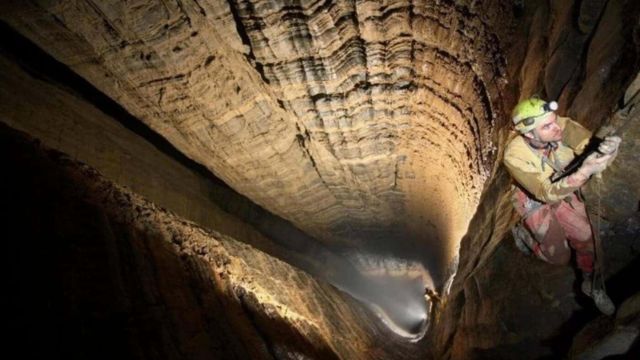The Earth’s crust conceals a network of awe-inspiring chasms, each a testament to the intricate dance of geology, time, and the ceaseless work of water. These profound abysses beckon both scientists, in pursuit of knowledge, and daring explorers, yearning to tread where no one has ventured before.
The creation of these caves is a millennia-long process, with alkaline rocks dissolving under the slightly acidic touch of water, carving out extensive passages and creating spectacular geologic sculptures like stalactites, which grace cave ceilings and grow at the painstakingly slow rate of mere millimeters per year.
Among the roster of Earth’s deepest caves, the ones listed here are based on the most current data, yet the potential for new discoveries looms large, hinting at the ever-present possibility of reshaping our understanding of these subterranean wonders.
Exploring the Depths: A Glimpse into the Abyss
- Veryovkina Cave: Crowned as the deepest cave on Earth, nestled in the contentious territory of Abkhazia, Georgia, Veryovkina Cave plunges to depths of 7,257 ft and stretches over 10.9 miles. Discovered in 1968 and only fully explored in recent years, it showcases a complex network of pits and galleries, adorned with stalactites and stalagmites, yet poses significant risks with its frequent floods and vertical drops.
- Krubera-Voronja Cave: Once the world’s deepest cave, Krubera-Voronja descends 7,215 ft and extends 14.3 miles into the heart of Abkhazia. Known for its challenging water-filled passages and the hazards of hypothermia and flooding, it remains a focal point for intrepid explorers.
- Sarma Cave: Residing within the Arabika Massif, Sarma Cave is known for its expansive halls and intricate channels, reaching a depth of 6,004 ft. Despite the dangers presented by sudden water level rises, it continues to captivate those allowed within its depths.
- Snezhnaja Cave: This labyrinthine system is renowned for its difficulty and the spectacular Throne Hall and Hall X, making it a site of both historical significance and geological interest.
- Lamprechtsofen: Woven into the legends of the Leogang Mountains, Austria, this cave reaches 5,692 ft deep and offers public access to a fraction of its vast network, highlighting natural waterfalls and vast chambers.
- Gouffre Mirolda: In the French Alps lies Gouffre Mirolda, a cave that plunges 5,686 ft deep. Discovered in 1971 but not fully explored until decades later, it presents an underground spectacle adorned with countless stalactites.
- Gouffre Jean-Bernard: Also in the French Alps, this cave delves 5,305 ft deep into the earth, featuring a complex network of shafts and galleries shaped over eons by underground water flow.
- Sistema del Cerro del Cuevón: Anchored in Spain’s Picos de Europa, this system is the nation’s deepest chasm and the world’s eighth deepest, challenging explorers with its depth and the mysteries of its gas emissions and seismic movements.
- Hirlatzhöhle: Nestled in Austria’s Dachstein Mountains, Hirlatzhöhle commands respect with its depth of 5,118 ft and a length of 70.2 miles, presenting formidable challenges to those who dare explore it.
- Sistema Huautla: In Oaxaca, Mexico, this cave is not just the Western Hemisphere’s deepest but also a sacred site for the indigenous Mazatec people. Its interconnected caverns and the serene lake at its bottom continue to unravel new secrets.
Beyond the Depths: The Essence of Exploration
These cavernous realms are more than mere geological formations; they are vibrant ecosystems and historic vaults that have witnessed the daring spirit of human exploration. The journey into these depths is fraught with danger and unknowns, underscoring the blend of depth, danger, and desire that defines our fascination with the planet’s most profound chasms.
As explorers and scientists push the boundaries of these caves, they not only challenge the limits of human endurance and curiosity but also deepen our understanding of Earth’s dynamic and ever-evolving landscape.

